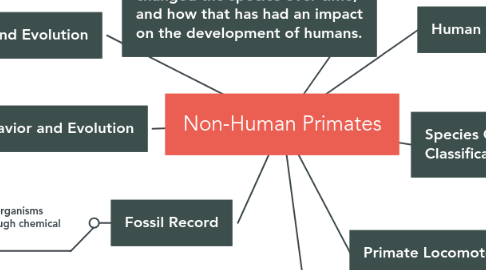Non-Human Primates
by Arabella Hoffman


1. Primate Taxonomy and Evolution
1.1. Taxonomy is classified under four main categories: Kingdom (Animalia), Phylum (Chordata), Class (Mammalia), Order (Primates).
1.1.1. Primates can also be categorized into other sub groups which are strepsirrhines, haplorrhines, anthropoids, or prosimians.
2. Primate Behavior and Evolution
2.1. The social behavior of primates are strategies or behaviors that increase an individual's fitness.
2.1.1. Social groups are reflected by residence patterns that impact their group living.
2.1.1.1. Other aspects of primate behavior are competition, cooperation, culture, parenting behaviors, tool use, and language.
3. Fossil Record
3.1. Fossils are the remains of organisms transformed into rock through chemical replacement.
3.1.1. Studying fossils reveals information about biological changes and how the time, setting, and environment impacts evolutionary changes
4. An interesting fact from this module was learning about the woman who gave birth to 69 children. I had no idea a women's body could ever be capable of doing this!
5. It is important to study non-human primates to understand how evolution has changed the species over time, and how that has had an impact on the development of humans.
6. Species Concepts and Classification
6.1. Primatology is the study of behavior, ecology, anatomy, and evolution of non-human primates.
6.1.1. Characteristics of primates are arboreal adaptation, dietary plasticity, and high parental investment.

